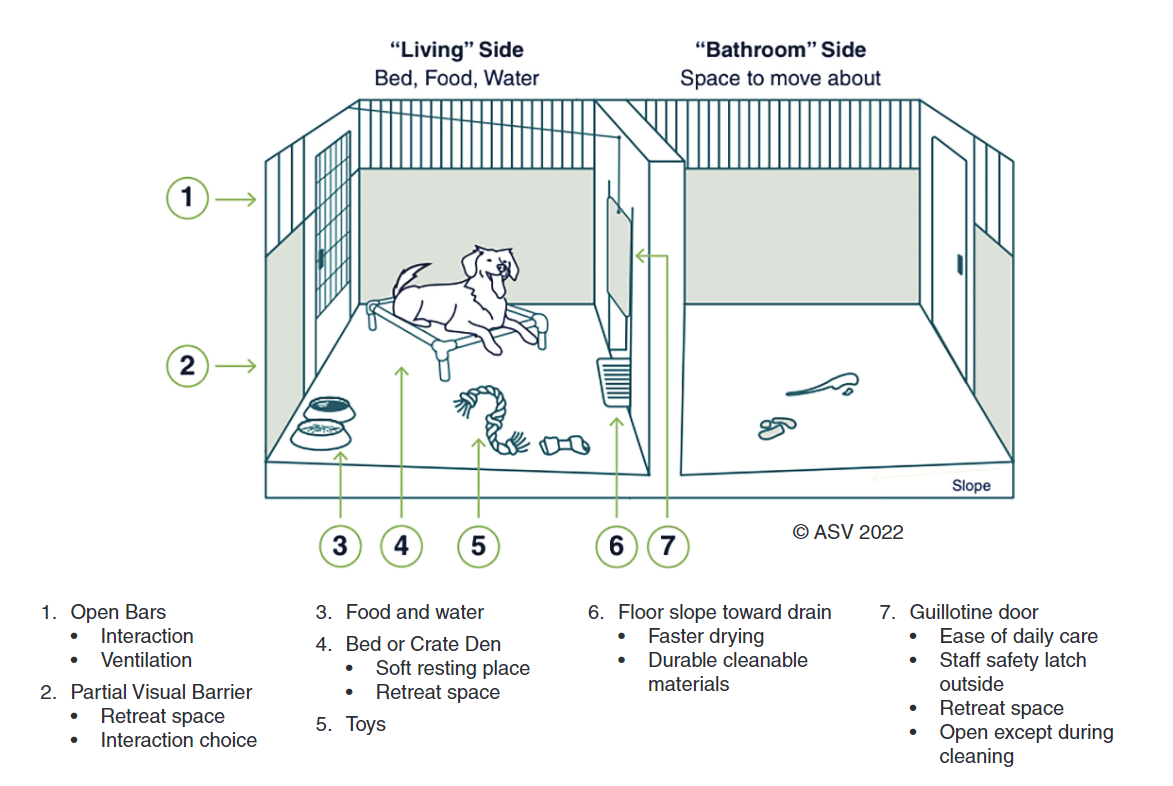One of the first steps to making your domestic violence or homeless shelter pet-inclusive, is deciding how and where you will house clients’ pets. In-room housing, which involves housing pets in the same space as their owners, is often the preferred and more affordable option. However, it may not always be feasible at every shelter. Instead, many shelters choose to create a dedicated room or addition specifically for pet housing. The design of these spaces can vary widely depending on your available space, budget, and goals, but they should all incorporate certain fundamental design elements to maintain animal welfare standards. In the following article, we’ll outline some best practices established by expert veterinarians to assist you in making informed design decisions.
Definitions
Primary enclosure: an area of confinement such as a cage, kennel, or housing unit where an animal spends the majority of their time.
Double-compartment housing: animal enclosures designed with two separate housing areas connected by a door, pass-through, or portal.
Enrichment: the process of improving the care of confined animals by providing them with social interaction, physical and mental stimulation, opportunities to perform species-typical behaviors, and choice and control over their environment.
Co-Housing: keeping more than one animal of the same species in an enclosure, also known as “group housing”.
Enclosure Size
The size of a pet’s primary enclosure can have a dramatic impact on their day to day life and overall well being. It will also serve as a key metric in conversations with architects and contractors as they draft initial designs for your space, so make sure to share this information with them early! Because a pet’s primary enclosure is where they will spend most of their time, it’s essential that this space allow them enough room to express natural behaviors, exercise choice, and move around comfortably. Pets must also be able sit, sleep, and eat away from areas of their enclosures where they defecate and urinate.¹
Cats
Individual adult cat housing should provide a minimum of 8 ft² of floor space; however, 11 ft² or more is greatly preferred.¹
Dogs
For dogs, minimum recommended kennel dimensions differ widely based on body size. In general, a 4 ft wide minimum is recommended for medium to large dogs (25 – 90 lbs) while a 6 ft wide minimum is recommended for extra large dogs (> 90 lbs). In terms of kennel length, 9 ft is generally a minimum; however, 10 – 12 ft or more is preferred.²
Keep in mind that the above guidelines represent a minimum standard of care for animals residing in short-term temporary housing (up to two weeks). When determining the size of enclosures at your shelter, make sure to consider your anticipated length-of-stay. As a pet’s time in shelter increases, so do their space and enrichment needs.
Enclosure Layout
While the importance of sufficient enclosure size can’t be overstated, it’s not the only factor to consider when setting up your pet housing. The layout of the enclosure and the care items provided are equally important in meeting the welfare needs of sheltered pets. Double compartment housing is strongly recommended for both cats and dogs, as it provides more choice and control over their environment and interactions, reduces stress, and allows for easy cleaning.¹
Cats
All cats must be given the opportunity to hide within their primary enclosure. Access to an appropriate hiding place can help cats feel safe and secure and decrease symptoms of stress. Cardboard boxes, perches covered with towels, and partial coverings over enclosure doors are all great ways to meet this need for cats at your shelter! To ensure that cats can display natural behaviors, their primary enclosure must also allow for scratching, climbing, and perching. When it comes to litter boxes, all cats should be provided with a litter box large enough to comfortably accommodate their entire body and allow for proper posturing.¹

Dogs
Primary enclosures with indoor–outdoor access are ideal for most dogs, especially when housed long term.¹ In fact, simply providing dogs with a choice to move between indoor and outdoor sides of their enclosures can help reduce stress and improve their physical and behavioral health.³ To ensure comfort, keep dogs dry, and support thermoregulation, all dogs should be provided with a soft resting place that elevates them off of the floor.¹ Like cats, dogs also benefit from the opportunity to hide within their enclosure. Options for canine hiding areas include a covered crate within the enclosure or a visual barrier over part of the kennel front.¹

Temperature
Temperature can have a significant impact on pets’ comfort and health, so make sure to consider this when designing your pet housing. To ensure humane and safe conditions, the temperature of a pet’s primary enclosure should be maintained between 64°F and 80°F.¹ Keep in mind however, that breed, body condition, age, medical health, and other factors will influence an animal’s specific needs. Brachycephalic or “flat-nosed” dog breeds like pugs, bulldogs, and boxers are particularly susceptible to heat exhaustion and may begin to show signs of stress when temperatures rise above 75°F. On the other hand, short-coated pets, senior pets, or pets with low body condition scores may need additional warming elements to maintain their body temperature on cool days. Shelter staff and pet owners should monitor pets individually to ensure that they are comfortable and take necessary steps if they appear too hot or too cold.
Humidity
The relative humidity of an animal’s primary enclosure should be maintained between 30% and 70%.¹ If you live in a particularly humid climate, a reliable dehumidifier can be purchased for as little as $200 and can help ensure appropriate moisture conditions for pets in your care.
Lighting
Just like humans, pets have biological rhythms that are affected by light. Exposure to sunlight in a manner that maintains daily circadian rhythms will improve the health and well-being of animals in your care.¹ When designing your pet housing, consider designs that offer as much natural light as possible. If natural lighting isn’t available and artificial light is used, it should approximate natural light in duration and intensity. Ideally, lights should be turned off at night to allow pets to settle and sleep normally. If it is absolutely necessary to keep lights on after dark for safety or by regulation, a fixture that emits red-orange light is preferred.¹
Enrichment
Daily enrichment is an essential part of animal care. Proper enrichment reduces stress and boredom and improves quality of life. Enrichment can also help pets build positive behaviors, making them better residents while in your shelter and more attractive rental candidates when your client is ready to apply for permanent housing. Enrichment activities should be offered daily and should include positive social interaction, mental stimulation, and physical activity.¹
Examples of enrichment may include: food puzzles, scent games, interactive toys, outdoor walks or runs, digging, swimming, climbing, social play, training sessions, and much more!
Cats
Cats must be offered regular opportunities to express natural behaviors, including physical activity and exploration. This can include time outside of their primary enclosure to exercise and explore in a secure, enriched setting. However, removal to a new location may not always be preferred or necessary for cats living in spacious, enriched rooms.¹ Within their enclosure, all cats need the opportunity to rest comfortably, hide, perch, scratch, play, and exercise choice.¹
Dogs
Daily time out of their primary enclosure is one of the most effective means of reducing stress and frustration in kenneled dogs.¹ Additionally, all dogs need the opportunity to rest comfortably, retreat from view, chew, play, and exercise choice within their primary enclosure.¹ Food enrichment is a simple and effective way to provide mental stimulation to sheltered dogs. Food enrichment items can be purchased from most pet supply retailers, or even made at home for a fun DIY project!
Species Separation
When housing pets of different species, it’s important to remember that “predator” and “prey” species must be housed separately. For example, cats should never be housed in an area where they can see, hear, or smell unfamiliar dogs. This type of proximity leads to heightened stress and fearfulness which can jeopardize both physical and mental health.¹
While cats are a prey species to dogs, they are also a predator species to animals like birds, rabbits, guinea pigs, and other small rodents. If you choose to open your shelter to these small pets, they must be housed away from both dogs and cats.
Co-Housing
In some circumstances, co-housing can improve animal welfare by facilitating social interaction and providing pets with a larger, more enriched space.¹ However, it’s important to keep in mind that co-housing is not suitable for every situation. Some individual housing should always be available for pets that do not do well in a group.
Cats
When cats are co-housed, a minimum of 18 ft² of floor space should be provided per cat.¹ Regardless of the size of the space, no more than 8 – 10 cats should be housed per room. However, 2 – 4 cats per room is preferred.⁴ The number of hiding spaces and elevated resting surfaces provided should, at minimum, be equal to the number of cats housed plus one. A minimum of 2 non-adjacent litter boxes and feeding/watering stations should be provided for small population rooms. As the number of cats increases, the number of feeding stations and litter boxes will also need to increase.⁴
Dogs
To maintain safety and avoid liability, Don’t Forget the Pets strongly recommends that human service providers do not attempt to co-house dogs from different households. However, dogs from the same household may benefit from being housed together if the client reports that they have a positive history of sharing space.
When dogs are co-housed, a minimum kennel width of 6 ft is generally recommended. A minimum kennel length of 9 ft is recommended, but 10 – 12 ft is preferred.⁴ Regardless of enclosure size, no more than 2 – 4 adult dogs should be co-housed; however 2 is preferred.⁴ As the size and number of dogs increase, kennel size will also need to increase. Separation at feeding time is recommended and often required to ensure that each dog has sufficient food, and a minimum of one bed per dog should be provided.⁴
Finally, keep in mind that it is not uncommon for pets’ behavior to change when they enter a shelter environment. Even pets who have a positive history of living together may not get along when stress is high and space is tight. Make sure to keep a close eye on co-housed pets and be prepared to move them into individual housing if necessary.
Final Thoughts
Just like people, pets often struggle to transition into shelter, learn new routines, and find comfort in unfamiliar surroundings. Taking time to create thoughtfully-designed pet housing can make an incredible difference in the behavior and overall well being of pets in your care.
Keep in mind that the recommendations in this article represent a minimum standard for care for pets residing in short-term temporary housing. Animals remaining in shelter long-term (i.e. more than 2 weeks) must be provided with additional space, enrichment, and choice to maintain their wellbeing.
Still have questions or need support? Don’t Forget the Pets is committed to helping you create the best possible pet housing for your shelter. Contact us at danielle@redrover.org or check out our Coaching Program for customized design support. We’re here to help!
¹ Journal of Shelter Medicine and Community Animal Health, “The Association of Shelter Veterinarians’ Guidelines for Standards of Care in Animal Shelters”. Second Edition. 2022. https://jsmcah.org/index.php/jasv/issue/view/2
² UC Davis Koret Shelter Medicine Program, “All you need to know about housing dogs in animal shelters”. 2016. https://www.sheltermedicine.com/library/resources/?r=all-you-need-to-know-about-housing-dogs-in-animal-shelters#:~:text=In%20general%20a%20~4%27%20wide,Kennel%20lengths%20vary%20widely
³ American Kennel Club, “Setting Puppies and Dogs Up for Success: Designing Kennels with Behavior and Welfare Considerations in Mind”. 2019. https://www.akc.org/expert-advice/dog-breeding/designing-kennels-with-behavior-and-welfare-considerations-in-mind/
⁴ UC Davis Koret Shelter Medicine Program, “Facility Design and Animal Housing”. 2015. https://www.sheltermedicine.com/library/resources/?r=facility-design-and-animal-housing#Cats
Danielle Works is the Community Engagement Manager for RedRover. With more than 10 years of experience in animal welfare, Danielle consults with shelters throughout the country to identify collaborative solutions for pets and owners in crisis. She holds a Bachelor’s degree in Biology from Willamette University in Salem, Oregon.



